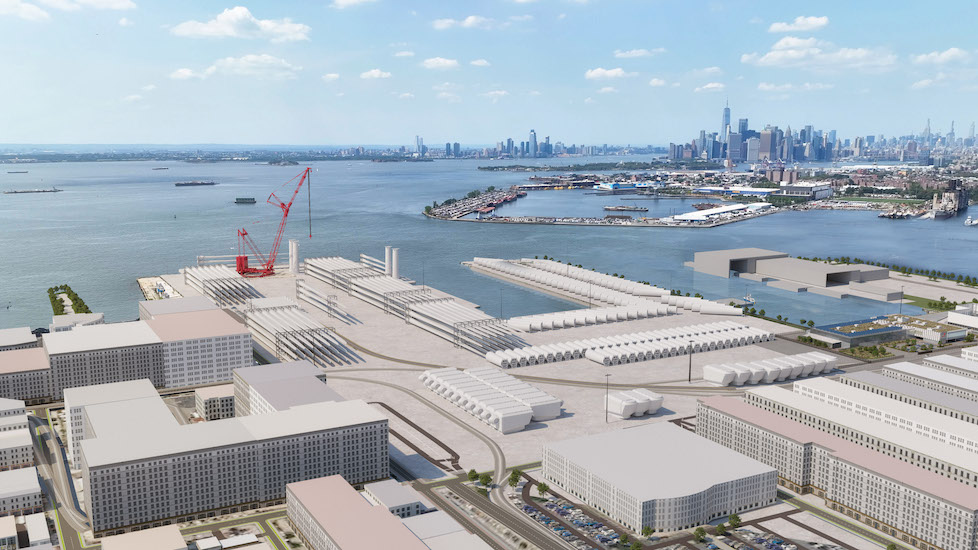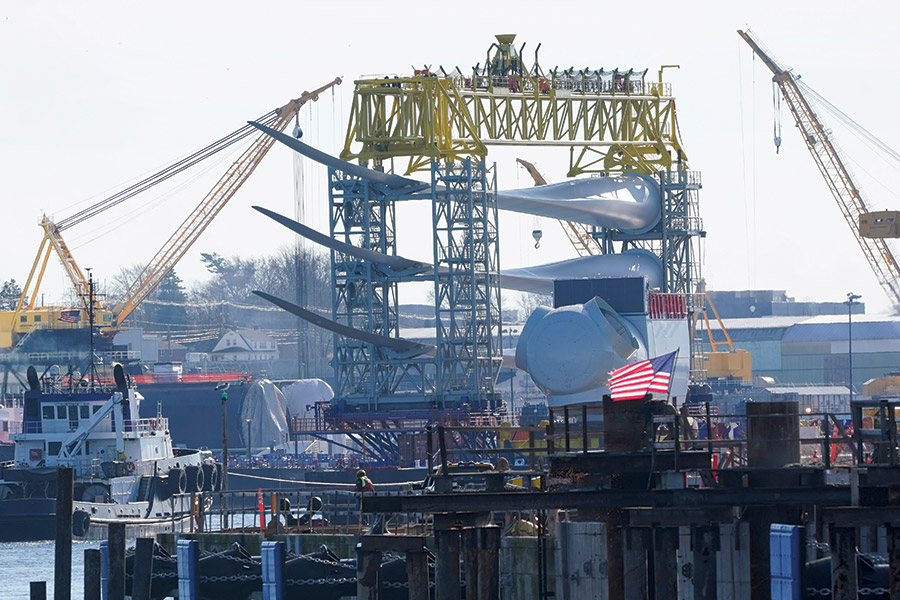New York scurried this week to advance a new plan for offshore wind energy capacity after cancelling on April 19 about 4 GW of awards last year to developers of three projects when their turbine manufacturer, GE Vernova, said it would scale down the size of machines it could deliver.
The projects had specified use of giant 18-MW turbines that were to be built in an Albany, N.Y. area plant with $300 million in state funding, but GE Vernova revised them to 15.5-MW to 16.5-MW capacity, facing industry market challenges. The added redesign cost to include more generation units undermined project economics.
GE Vernova termed its smaller Haliade turbine a “workhorse ... based on proven technology,” in a statement, with a prototype set to operate by the end of 2025. But a spokesperson did not respond to ENR queries on the turbine change or on the firm’s future role in New York projects. An unidentified firm “representative” told industry publication Recharge that the contracts' implosion was due more to "non-turbine project challenges," including lack of large enough installation equipment.
The New York State Energy Research & Development Authority (NYSERDA) called the manufacturer’s decision a “material change” that “resulted in technical and commercial complexities between provisional awardees and their supply chain partners that have rendered projects unable to proceed under the awarded terms.”
In April 25 first quarter results comments to stock analysts, CEO Scott Strazik said the firm would continue its offshore wind sector focus, but turbine economics must be “materially different” than those now in its backlog, mostly that were priced and signed at a time of cheaper borrowing costs, low inflation and aggressive bidding in emerging markets. The firm's wind business lost $1 billion last year, it reported.
“There is a lot of complexity in offshore wind we are learning from,” he said, although not commenting on future manufacturing in New York, according to Recharge. CFO Ken Parks said GE Vernova expects turbine revenue and profit improvements in the second half of 2024, mostly driven by onshore wind work.
Staying the Course
NYSERDA, which manages New York's energy transition, announced April 23 a request for information to accelerate a new procurement of up to 2.6 GW of offshore wind contracts—likely to include rebids of some awarded projects. About $300 million in state funding toward GE Vernova’s plan to build supporting component plants in the state will be repurposed, the agency said.
[UPDATE: The agency said April 29 that it made provisional awards to 24 onshore wind and solar projects that would add 2.4 GW to the state capacity total. Some could be in operation by next year, said NYSERDA. But as of 2022, 29% of state generated power was renewable, mostly from hydroelectric sources, according to state statistics referenced by Recharge.]
In comments April 24 at the International Partnering Forum wind conference in New Orleans sponsored by sector trade group Oceantic Network, NYSERDA President and CEO Doreen Harris noted plans for the new procurement would start "as early as this summer," to include a $200-million solicitation for funding for "supportive supply chain and logistics."
New York in 2019 set the most ambitious U.S. offshore wind target of 9 GW operating by 2035 and 70% of its generation to be clean power by 2030. President Joe Biden has a stated goal to deploy 30 GW of U.S. offshore wind by 2030, although its feasibility now is debated.
But existing state offshore wind development efforts continue.
Contractor Skanska said April 26 that it received a "final award" of $861 million from a unit of Equinor, another current state offshore wind developer, to complete overhaul of the South Brooklyn Marine Terminal "into one of the largest dedicated offshore wind ports in the USA." The facility is set to support the developer's Empire Wind 1 project to be built about 15 to 30 miles south of Long Island and operating by 2026.
Equinor in March announced a project labor agreement with the Building & Construction Trades Council of Greater New York and Vicinity for site construction.
Skanska said the contract will involve demolition of existing buildings, dredging of new and existing berths, bulkhead upgrades, installation of new wharf and dock facilities and construction of an offshore wind staging area and new 85,000 sq ft operations and maintenance building. Work under the contract will extend into 2026, Skanska said.
"The port will serve as the operational and maintenance hub for the wind farm, and as the point of interconnection to integrate power from Empire Wind 1 to New York's electricity grid at the Gowanus substation in Brooklyn," an Equinor spokesman told ENR.
The port is "being designed to support work beyond" the contracted 810-MW, 130-turbine Empire Wind 1, the spokesman said. Equinor terminated its contract for a future 1,200-MW Empire Wind 2 in early 2024, citing cost issues, with U.S. unit President Molly Morris announcing a project "reset."
"It's too early to know on Empire Wind 2," the spokesman added. "We are committed to developing it and will continue to de-risk and mature the project in search of offtake opportunities in future solicitations."
Equinor had also been co-owner of the planned Beacon wind projects with oil giant bp, but the developers agreed to split their holdings at the same time. The first phase Beacon project was described initially as 1,250-MW capacity, but its development status now by bp remains unclear since the split with Equinor.
Empire 1 turbine components will be produced by turbine maker Vestas in Europe and installed by marine logistics giant Maersk, with "some pre assembly" at the Brooklyn hub, said the Equinor spokesman. Turbines will be installed by a new US compliant vessel that is set for delivery to the site in 2026, he said.

Contractor Skanska said April 26 that it received a "final award" of $612 million from a unit of NY offshore wind developer Equinor, to complete overhaul of the South Brookyln Marine Terminal "into one of the largest dedicated offshore wind ports in the USA."
Rendering ourtesy of Equinor
Market Dynamics
Noting the need to "adapt to changing market conditions," Harris said New York "will maintain its commitment to this industry." She added that despite "some second-guessing on where we’re heading now, we are planning for the future."
Harris did not provide added details, and NYSERDA did not elaborate on how the turbine challenge would be addressed in the next procurement. But separating power generation and supply chain investment is one strategy to provide developers "a bit more flexibility with respect to supply chain partners that they work with,” she told Recharge.
Also at the offshore wind event, Amanda Lefton, vice president of RWE, one developer with a cancelled project, acknowledged a likely rebid. "RWE is completely committed to move forward," she said. "It's not an if, it’s a when. We are focused on de-risking our projects to insure they are successfully developed and built.”
NYSERDA's Harris also said the state wants Interior to lease an added 36,000 acres in the New York Bight waterway south of New York City—the site of a successful federal auction in 2022 of about 488,000 acres. The three cancelled projects had been set to be built there.
US Interior Secretary Deb Haaland told conference attendees that a new federal site leasing expansion, would include up to 12 potential auction sales through 2028 in the Atlantic and Pacific Oceans, Gulf of Mexico—four in 2024, one each in 2025 and 2026, two in 2027 and four in 2028.
Interior says the first two are in deep water in the Gulf of Maine and off the Oregon coast, with power potential of 18 GW, but requiring floating turbine platforms. Eight areas in the former totaling 1 million acres and 15 GW are proposed, and two areas of nearly 195,000 acres for the latter. The department seeks comment through July 1 on lease area size and location, impacts on fishing interests and tribes, and proposed credits for bidders that commit to boost workforce and supply chains.
The leases are part of a department final rule to streamline project permitting deployment it said would save developers $1.9 billion over 20 years.
The schedule "will provide predictability" for developers and communities in offshore wind supply chain and manufacturing investments, Haaland said, noting that the government has so far approved more than 10 GW of offshore wind projects.
But one oil and gas advocacy group also notes needs for more lease sales in that sector, claiming only three are set in the next five years. "Periods of inactivity in lease sales ... only increase uncertainty and risk driving investment dollars overseas," said Erik Milito, National Ocean Industries Association president. "Sustaining regular lease sales for all energy sources ensures energy continuity, promotes economic growth and maintains America’s competitiveness" in the global energy market.
"Offshore wind will have an incredibly important role worldwide and will move past current challenges," U.S. Energy Dept. Deputy Secretary David Turk told the offshore wind conference. "This is not a test we can afford to fail.”
DOE added a boost with $48 million for offshore wind R&D announced on April 24 as part of the agency's long term strategy for sector "commercial liftoff."
Eric Hines, a veteran sector research engineer who directs the offshore wind engineering graduate program at Tufts University told ENR that the New York cancellation "reinforces our collective U.S. understanding of the scale and interconnectedness of this new industry—challenging us to build domestic procurement systems and a supply chain that can deliver $5 billion dollar-plus projects at regular intervals for the next several decades."
He added that while 18-MW turbines "may have been critical to these particular bids [in New York], they are not necessary for offshore wind to thrive in the U.S."






Post a comment to this article
Report Abusive Comment